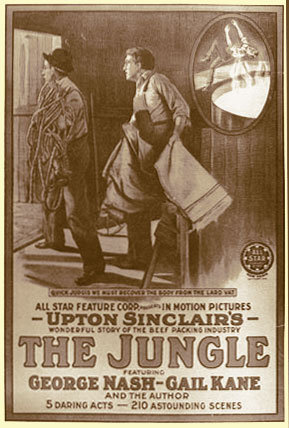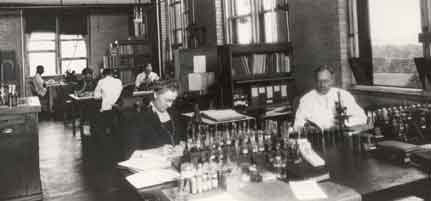Usa Penalty for Adulterating Food in Beef Production
Part I: The 1906 Food and Drugs Act and Its Enforcement
While Wiley was stumping for a law, muckraking journalists such as Samuel Hopkins Adams exposed in vivid detail the hazards of the marketplace. In fact, the nauseating condition of the meat-packing industry that Upton Sinclair captured in The Jungle was the final precipitating force behind both a meat inspection law and a comprehensive food and drug law. (A poster of the 1913 movie adaptation of Sinclair's novel is pictured at right, courtesy of the Sinclair Archives, Lilly Library, Indiana University, through James Harvey Young's Pure Food: Securing the Federal Food and Drugs Act of 1906.) Since 1879, nearly 100 bills had been introduced in Congress to regulate food and drugs; on 30 June 1906 President Roosevelt signed the Food and Drugs Act, known simply as the Wiley Act, a pillar of the Progressive era.
This act, which the Bureau of Chemistry was charged to administer, prohibited the interstate transport of unlawful food and drugs under penalty of seizure of the questionable products and/or prosecution of the responsible parties. The basis of the law rested on the regulation of product labeling rather than pre-market approval. Drugs, defined in accordance with the standards of strength, quality, and purity in the United States Pharmacopoeia and the National Formulary, could not be sold in any other condition unless the specific variations from the applicable standards were plainly stated on the label. Foods were not defined according to analogous standards, but the law prohibited the addition of any ingredients that would substitute for the food, conceal damage, pose a health hazard, or constitute a filthy or decomposed substance. Interpretations of the food provisions in the law led to many, sometimes protracted, court battles. If the manufacturer opted to list the weight or measure of a food, this had to be done accurately. Also, the food or drug label could not be false or misleading in any particular, and the presence and amount of eleven dangerous ingredients, including alcohol, heroin, and cocaine, had to be listed.
The bureau's regulatory emphasis under Wiley centered on foods, which he believed posed a greater public health problem than adulterated or misbranded drugs. Wiley generally held a dim view of chemical additives to foods, championing an approach that considered most to be unnecessary adulterants. On this he clashed often with Secretary of Agriculture James Wilson, and on occasion President Roosevelt himself had to decide government policy on food regulation. Wiley's personal administrative authority under the act was diluted early on when Wilson created a Board of Food and Drug Inspection in 1907 to establish agency policy in enforcing the law. Similarly, the creation of the Referee Board of Consulting Scientific Experts in the following year to advise the department on safety issues associated with food additives undercut Wiley's scientific authority. The bureau had been developing informal standards for many foods in collaboration with outside experts since 1903, an activity that continued after the 1906 act. However, courts differed on the role these informal standards could play in cases. Separate laws established standards for some specific foods, such as apples and butter, as well as for canned foods.
Burton J. Howard, chief of the Bureau of Chemistry's microchemical laboratory, is shown in the right foreground in this photo from the 1920s. Howard developed a quantitative method to detect mold in ketchup that proved to be indispensable in establishing food adulteration in court.
After Wiley's resignation in 1912, the bureau devoted more effort to drug regulation, with some emphasis on the so-called patent medicines. While the law was much clearer about drug standards than standards for foods, misbranding was the source of considerable controversy in the regulation of drugs. A year earlier the Supreme Court ruled that the law did not--contrary to the government's interpretation--apply to false therapeutic claims. An amendment in the year of Wiley's resignation attempted to correct the language of the law. But it put the bureau in the difficult position of attempting to prove in court that manufacturers of drugs labeled with false therapeutic claims intended to defraud consumers. The bureau lost several cases against egregious products, but seizures of misbranded and adulterated drugs nevertheless increased in the 1920s and 1930s.
Next: The 1938 Food, Drug, and Cosmetic Act
Source: https://www.fda.gov/about-fda/changes-science-law-and-regulatory-authorities/part-i-1906-food-and-drugs-act-and-its-enforcement


0 Response to "Usa Penalty for Adulterating Food in Beef Production"
Enregistrer un commentaire